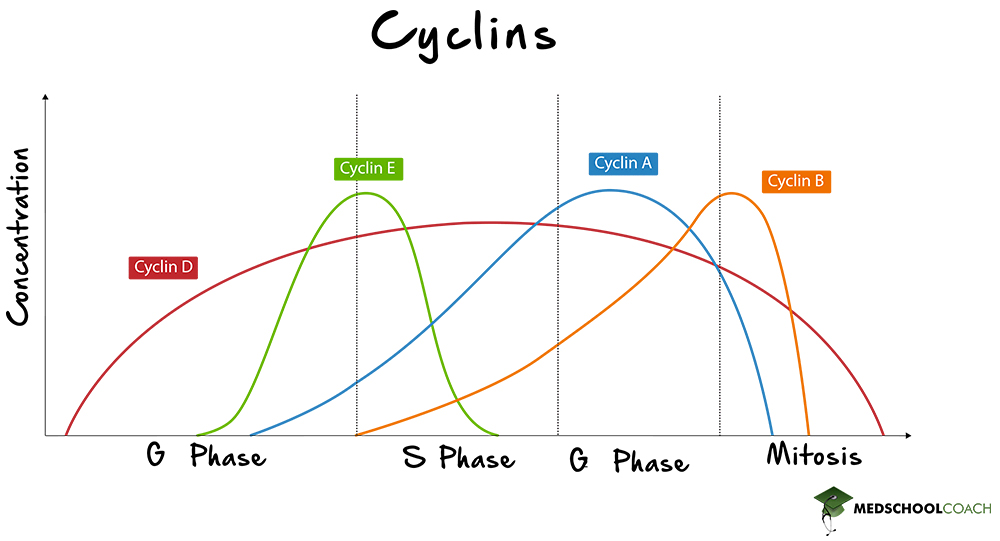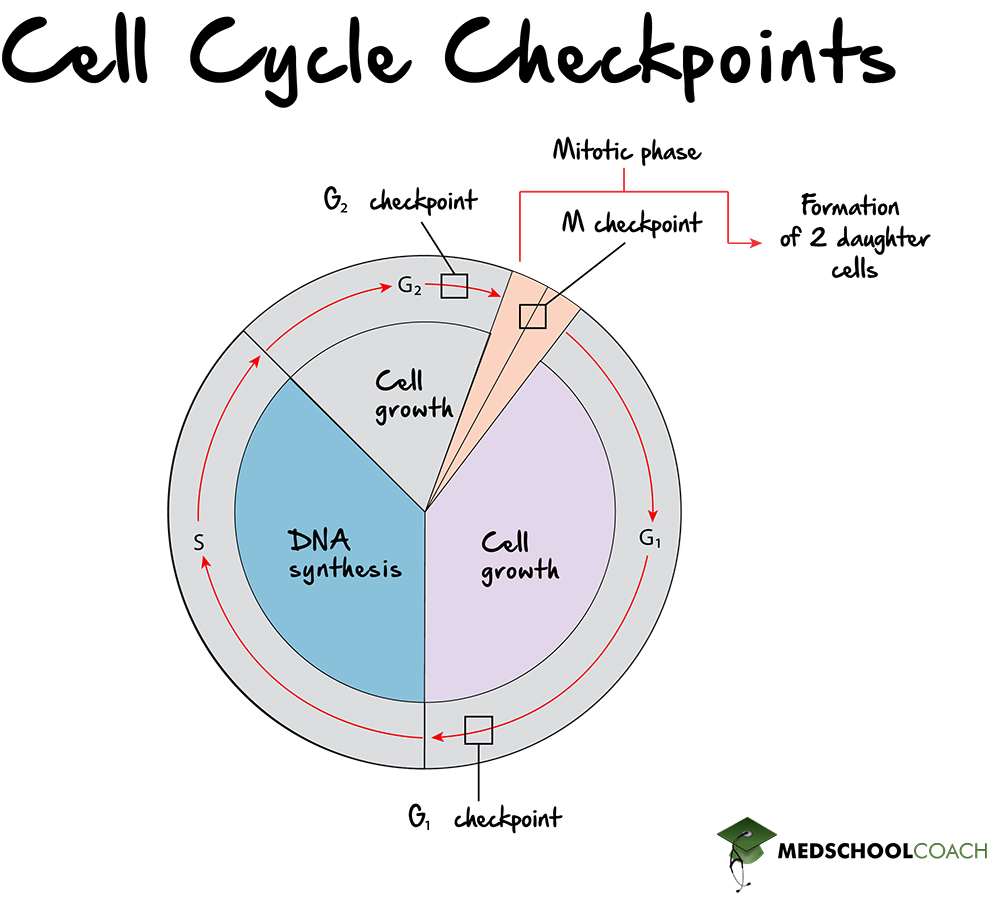The Cell Cycle
MCAT Biology - Chapter 3 - Section 1.1 - Cell Division - The Cell Cycle
- Home
- »
- MCAT Masterclass
- »
- Biological and Biochemical Foundations of Living Systems
- »
- Biology
- »
- The Cell Cycle – MCAT Biology
Sample MCAT Question - The Cell Cycle
a) It determines whether or not the cell enters the M phase
b) It checks to see if sister chromatids are attached to the mitotic spindle
c) It checks for errors in DNA replication
d) It determines whether or not the cell will enter the S phase
D is correct. The G1 checkpoint determines the cell’s entry into the S phase.
The G1 checkpoint of the cell cycle also called the restriction point, determines whether or not the cell will proceed into the S phase. At this point, the cell checks whether it has adequate energy reserves and DNA damage. Energy reserves are essential because DNA replication is an energy-expensive process, and checking for DNA damage is important because the cell does not want to replicate with damage. Answer choice A is incorrect, this is a description of the G2 checkpoint. Answer choice B is incorrect because the M checkpoint performs this task. Answer choice C is incorrect, this is a job of the G2 checkpoint.
Get 1-on-1 MCAT Tutoring From a Specialist
With MCAT tutoring from MedSchoolCoach, we are committed to help you prepare, excel, and optimize your ideal score on the MCAT exam.
For each student we work with, we learn about their learning style, content knowledge, and goals. We match them with the most suitable tutor and conduct online sessions that make them feel as if they are in the classroom. Each session is recorded, plus with access to whiteboard notes. We focus on high-yield topics if you’re pressed for time. If you have more time or high-score goals, we meticulously cover the entire MCAT syllabus.
Intro to the Cell Cycle
The cell cycle is a series of processes that take place in a cell that results in the production of two identical daughter cells. The cell cycle is a 4-stage process that all actively dividing eukaryotic cells undergo. Figure 1 shows the stages of the cell cycle, which are the G1 phase, the S phase, the G2 phase, and the M phase. Another way to categorize the phases of the cell cycle is to use the terms interphase and mitosis. Interphase consists of the G1, S, and G2 phases. During interphase, the cell will undergo a series of changes that will prepare it for cell division. It is also known as the preparatory phase. Mitosis occurs when the cell undergoes division. It is essential to understand each stage in more detail for the MCAT exam.

The G1 Phase
The G1 phase is the first stage of interphase. It is also called the first growth phase. During this stage, there is a high rate of cellular activity, which may include the production of both proteins and cell organelles, such as mitochondria and ribosomes, and an increase in cell size. During the G1 phase, the cell is preparing for DNA replication. Also, at this point, the cell has a choice. It can either continue in the cell cycle and enter into the S phase or it can exit the cell cycle and enter the G0 phase.
The G0 Phase
The G0 phase is outside of the normal cell cycle. It is also known as quiescence and is a cycle for non-dividing cells. During this phase, cells are in a stable state, and the cellular processes in the cell are continuing as usual. Several mature cells that are fully differentiated, such as neurons, do not need to undergo cell division any longer. Therefore, neurons will enter into the G0 phase. It is important to note that in this phase, cells are continuing to produce proteins and organelles to carry out their functions.
S Phase
If a cell chooses to enter the S phase from the G1 phase, it will undergo DNA replication. The S phase is also known as the synthesis phase. Recall that DNA replication will result in the formation of two identical copies of DNA. At the end of this phase, all the chromosomes of the cell will have been replicated. Recall that each chromosome consists of two sister chromatids. Although the amount of DNA doubles, the number of chromosomes stays the same.
G2 Phase
After DNA replication in the S phase, the cell enters the G2 phase. The G2 phase is also called the second growth phase. Similar to the G1 phase, in the G2 phase, there is a high rate of cellular activity. However, unlike the G1 phase, which prepped the cell for DNA replication, the G2 phase preps the cell for mitosis.
Also, before entering mitosis, the cells are checked for DNA damage by a checkpoint protein called p53. If the DNA is damaged, p53 will either trigger DNA repair or apoptosis (cellular death). It is important to note that p53 is also known as a tumor suppressor protein, because if mutated, p53 will be unable to repair or destroy damaged DNA. In this way, the cell will continuously divide with damaged DNA, which can lead to several forms of cancer.
M Phase
The last phase of the cell cycle is the M phase or the mitotic phase. Two processes occur during this phase. First, there is mitosis, which involves the division of the nucleus into two identical nuclei. Recall that mitosis consists of several events divided into different phases: prophase, metaphase, anaphase, and telophase.
The second process in the M phase is cytokinesis, which involves the division of the cell into two identical daughter cells. In cytokinesis, the cell divides all of its components, such as its nuclei, cytoplasm, organelles, and cell membrane, into two cells. In this way, the M phase is the combination of both mitosis and cytokinesis.
Control of the Cell Cycle with Cyclins
Proteins called cyclins control the progression of the cell through the cell cycle. As seen in Figure 1, cyclin concentration varies throughout the cell cycle in a cyclical manner.

G1 Checkpoint
To complete the cell cycle, the cell must pass through different checkpoints. Figure 2 shows the G1, G2, and M checkpoints, which are the three main checkpoints of the cell cycle.
The G1 checkpoint, also called the restriction point, governs the cell’s entry into the S phase from the G1 phase. During the S phase, the DNA is replicated. Therefore, at the G1 checkpoint, the cell must check whether it has adequate energy stores to complete DNA replication. It also must check its DNA for damage in order to avoid passing DNA errors to the next generation of daughter cells. If the cell passes the G1 checkpoint, it commits itself to cell division and enters the S phase of the cell cycle.

G2 Checkpoint
The G2 checkpoint, also called the DNA damage checkpoint, governs the cell’s entry into the M phase from the G2 phase. Recall that DNA replication occurs in the S phase, which occurs directly prior to the G2 phase. Therefore, at the G2 checkpoint, the cell checks that replication has occurred correctly and that there is no damage to the DNA. If the cell passes this checkpoint, it enters the M phase or mitosis.
M Checkpoint
The M checkpoint, also called the mitotic spindle checkpoint, governs the cell’s entry into anaphase of mitosis. At this checkpoint, the cell checks that the sister chromatids are correctly attached to the mitotic spindle. If the cell passes this checkpoint, anaphase proceeds and the sister chromatids are pulled to opposite sides of the cell by the mitotic spindle.
Arrest of the Cell Cycle
If a cell does not pass a checkpoint due to DNA damage or an error in DNA replication, growth arrest (arrest of the cell cycle) occurs. If the cell experiences growth arrest, it first tries to repair the DNA damage or DNA replication error. If the damage or error can be repaired, growth arrest is reversed and the cell continues along the cell cycle. However, if repairs aren’t possible, the cell will either trigger apoptosis (programmed cell death) or will enter senescence (the permanent, irreversible arrest of the cell cycle).
Loss of Cell Cycle Controls in Cancer
Cancer is a group of diseases marked by uncontrolled cell growth and division. In cancer cells, genes which normally mediate growth arrest, as well as those which promote growth and division, are mutated. This results in the permanent activation of the cell cycle, beyond the normal control of growth arrest signals.
Explore More MCAT Masterclass Chapters
Take a closer look at our entire MCAT Masterclass or explore our Biochemistry lessons below.

One-on-One Tutoring
Are you ready to take your MCAT performance to a whole new level? Work with our 99th-percentile MCAT tutors to boost your score by 12 points or more!
See if MCAT Tutoring can help me
Talk to our enrollment team about MCAT Tutoring

MCAT Go Audio Course
Engaging audio learning to take your MCAT learning on the go, any time, any where. You'll be on the way to a higher MCAT score no matter where you are. Listen to over 200+ lessons.

MCAT Practice Exams
Practice makes perfect! Our mock exams coupled with thorough explanations and in-depth analytics help students understand exactly where they stand.

MCAT Prep App
Access hundreds of MCAT videos to help you study and raise your exam score. Augment your learning with expert-created flashcards and a question banks.